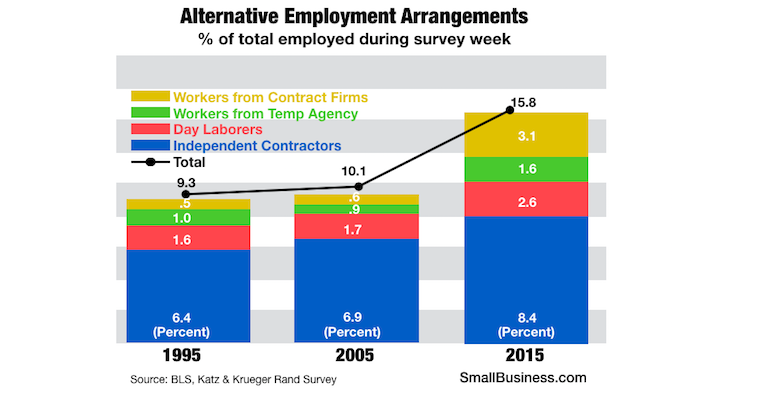According to economists Lawrence Katz and Alan Krueger, workers with alternative labor arrangements (ranging from on-demand “Uber” jobs to contract or “contingent” relationships) are probably being heavily under-counted by most economists. Katz, an economist at Harvard, and Krueger, an economist at Princeton, have released a preliminary report related to their recent research that claims “all net employment growth in the U.S. economy since 2005 appears to have occurred in ‘alternative work arrangements.'”
Alternative job growth during the past decade
10.1% | 2005: Share of workers in alternative work arrangements
15.8% | 2015: Share of workers in alternative work arrangements
14.2 million | Alternative jobs in 2005
23.6 million | Alternative jobs in 2015
9.5 million | Growth in alternative jobs between 2005 and 2015
Definition of an ‘alternative job’
The economists define “alternative” as any type of temporary “gig” (on-demand, temporary) or contract work, including the on-demand economy’s poster child: Uber drivers. (SmallBusiness.com and the IRS define this category of worker as small businesses of one, sole proprietors or self-employed.)
Re-running the data
The 2005 data used by the economists came from the Bureau of Labor Statistics’ (BLS) Alternative Work Supplement (AWS). However, the BLS has not fielded this survey since 2005 due to a lack of funding (the next one is planned for 2017). According to the news website Fusion.com, Katz says that traditional jobs (standard employment arrangements) actually declined by 0.4 million (0.3 percent) from 126.2 million in February 2005 to 125.8 million in November 2015. This led the economists to conclude that all U.S. net employment growth has occurred in nonstandard work arrangements for the last decade.
Why this doesn’t surprise us
The Katz-Krueger study is getting extensive press coverage. Most articles express surprise at how much the contingent workforce has grown over the past decade. The media are also surprised that most of this growth came from offline activities instead of online platforms like Uber and Elance.
A good example is the New York Times article With ‘Gigs’ Instead of Jobs, Workers Bear New Burdens. Key quote:
“If you believe the Silicon Valley sloganeers, we are in a “gig economy,” where work consists of a series of short-term jobs coordinated through a mobile app … But anyone who cares about the future of work in the United States shouldn’t focus too narrowly on the novelty of people making extra money using their mobile phones.
“There’s a bigger shift underway. That’s a key implication of new research that indicates the proportion of American workers who don’t have traditional jobs—who instead work as independent contractors, through temporary services or on-call—has soared in the last decade. They account for vastly more American workers than the likes of Uber alone.”
These findings are not the least bit surprising to anyone who has been paying attention to this space. The good news is that the growth of the contingent workforce is finally starting to be broadly accepted.
Photo: Uber.com

